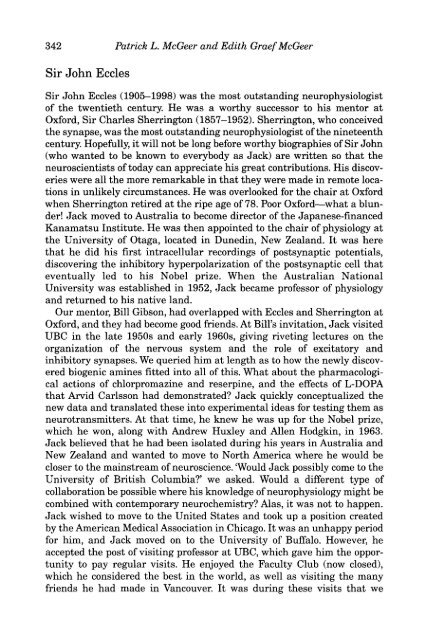Edith Graef McGeer - Society for Neuroscience
Edith Graef McGeer - Society for Neuroscience
Edith Graef McGeer - Society for Neuroscience
Create successful ePaper yourself
Turn your PDF publications into a flip-book with our unique Google optimized e-Paper software.
342 Patrick L. <strong>McGeer</strong> and <strong>Edith</strong> <strong>Graef</strong><strong>McGeer</strong><br />
Sir John Eccles<br />
Sir John Eccles (1905-1998) was the most outstanding neurophysiologist<br />
of the twentieth century. He was a worthy successor to his mentor at<br />
Ox<strong>for</strong>d, Sir Charles Sherrington (1857-1952). Sherrington, who conceived<br />
the synapse, was the most outstanding neurophysiologist of the nineteenth<br />
century. Hopefully, it will not be long be<strong>for</strong>e worthy biographies of Sir John<br />
(who wanted to be known to everybody as Jack) are written so that the<br />
neuroscientists of today can appreciate his great contributions. His discoveries<br />
were all the more remarkable in that they were made in remote locations<br />
in unlikely circumstances. He was overlooked <strong>for</strong> the chair at Ox<strong>for</strong>d<br />
when Sherrington retired at the ripe age of 78. Poor Ox<strong>for</strong>d—^what a blunder!<br />
Jack moved to Australia to become director of the Japanese-financed<br />
Kanamatsu Institute. He was then appointed to the chair of physiology at<br />
the University of Otaga, located in Dunedin, New Zealand. It was here<br />
that he did his first intracellular recordings of postsynaptic potentials,<br />
discovering the inhibitory hyperpolarization of the postsynaptic cell that<br />
eventually led to his Nobel prize. When the Australian National<br />
University was established in 1952, Jack became professor of physiology<br />
and returned to his native land.<br />
Our mentor. Bill Gibson, had overlapped with Eccles and Sherrington at<br />
Ox<strong>for</strong>d, and they had become good friends. At Bill's invitation. Jack visited<br />
UBC in the late 1950s and early 1960s, giving riveting lectures on the<br />
organization of the nervous system and the role of excitatory and<br />
inhibitory synapses. We queried him at length as to how the newly discovered<br />
biogenic amines fitted into all of this. What about the pharmacological<br />
actions of chlorpromazine and reserpine, and the effects of L-DOPA<br />
that Arvid Carlsson had demonstrated? Jack quickly conceptualized the<br />
new data and translated these into experimental ideas <strong>for</strong> testing them as<br />
neurotransmitters. At that time, he knew he was up <strong>for</strong> the Nobel prize,<br />
which he won, along with Andrew Huxley and Allen Hodgkin, in 1963.<br />
Jack believed that he had been isolated during his years in Australia and<br />
New Zealand and wanted to move to North America where he would be<br />
closer to the mainstream of neuroscience. 'Would Jack possibly come to the<br />
University of British Columbia?' we asked. Would a different type of<br />
collaboration be possible where his knowledge of neurophysiology might be<br />
combined with contemporary neurochemistry? Alas, it was not to happen.<br />
Jack wished to move to the United States and took up a position created<br />
by the American Medical Association in Chicago. It was an unhappy period<br />
<strong>for</strong> him, and Jack moved on to the University of Buffalo. However, he<br />
accepted the post of visiting professor at UBC, which gave him the opportunity<br />
to pay regular visits. He enjoyed the Faculty Club (now closed),<br />
which he considered the best in the world, as well as visiting the many<br />
friends he had made in Vancouver. It was during these visits that we











![[Authors]. [Abstract Title]. - Society for Neuroscience](https://img.yumpu.com/8550710/1/190x245/authors-abstract-title-society-for-neuroscience.jpg?quality=85)





